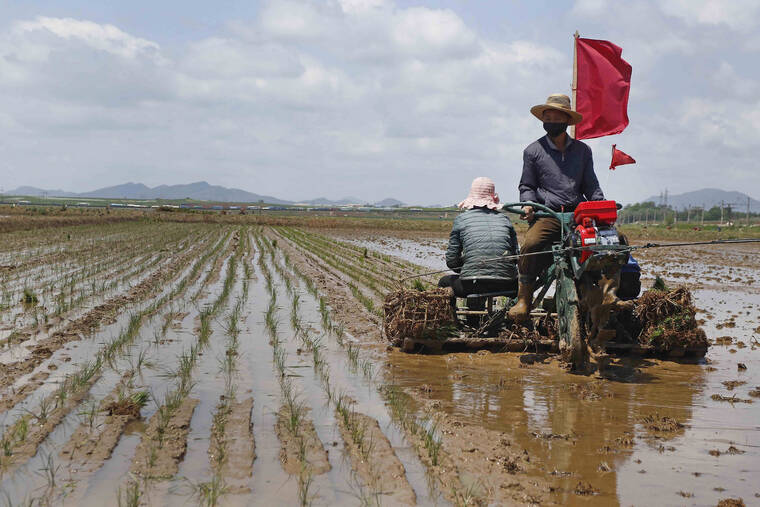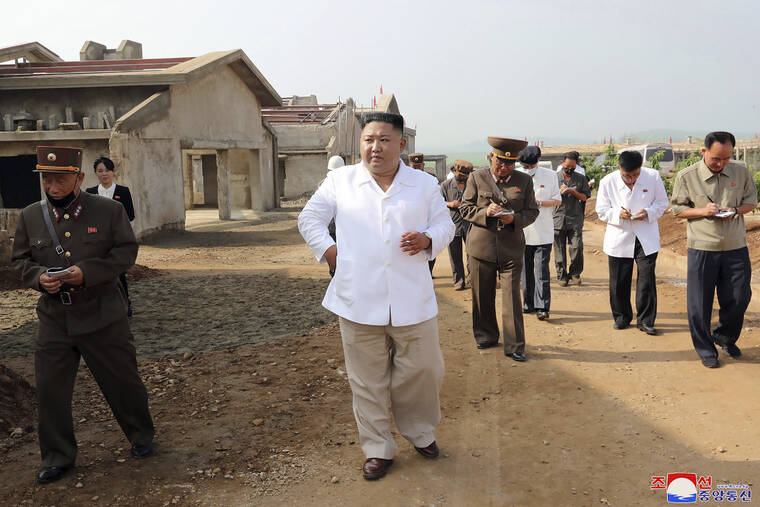N. Korea food shortage worsens amid COVID, but no famine yet

ASSOCIATED PRESS
Farmers plant rice at the Namsa Co-op Farm of Rangnang District in Pyongyang, North Korea, in May 2021. There’s little doubt that North Korea’s chronic food shortages worsened due to the COVID-19 pandemic, and speculation about the country’s chronic food insecurity has flared as its top leaders prepare to discuss the “very important and urgent task” of formulating a correct agricultural policy.

KOREAN CENTRAL NEWS AGENCY/KOREA NEWS SERVICE VIA ASSOCIATED PRESS
In this undated photo provided in July 2020 by the North Korean government, North Korean leader Kim Jong Un, center, visits a new chicken farm being built in Hwangju County, North Korea. Independent journalists were not given access to cover the event depicted in this image distributed by the North Korean government.


SEOUL >> There’s little doubt that North Korea’s chronic food shortages worsened due to the COVID-19 pandemic, and speculation about the country’s food insecurity has flared as its top leaders prepare to discuss the “very important and urgent task” of formulating a correct agricultural policy.
Unconfirmed reports say an unspecified number of North Koreans have been dying of hunger. But experts say there is no sign of mass deaths or famine. They say the upcoming ruling Workers’ Party meeting is likely intended to shore up support for North Korean leader Kim Jong Un as he pushes ahead with his nuclear weapons program in defiance of intense U.S.-led pressure and sanctions.
“Kim Jong Un can’t advance his nuclear program stably if he fails to resolve the food problem fundamentally because public support would be shaken,” said Lim Eul-chul, a professor at Kyungnam University’s Institute for Far Eastern Studies in Seoul. “The meeting is being convened to solidify internal unity while pulling together ideas to address the food shortage.”
An enlarged plenary meeting of the Central Committee of the Workers’ Party is slated for late February. Its specific agenda is unknown, but the party’s powerful Politburo earlier said that “a turning point is needed to dynamically promote radical change in agricultural development.”
The meeting will be the party’s first plenary session convened just to discuss agricultural issues, though they often are a key topic at broader conferences in North Korea. Raising grain output was one of 12 economic priorities the party adopted during a plenary meeting in December.
It is difficult to know the exact situation in the North, which kept its borders virtually closed during the pandemic. Food shortages and economic hardships have persisted since a famine killed an estimated hundreds of thousands of people in the mid-1990s.
Don't miss out on what's happening!
Stay in touch with breaking news, as it happens, conveniently in your email inbox. It's FREE!
In his first public speech after taking over from his father as leader in late 2011, Kim vowed that North Koreans would “never have to tighten their belts again.”
During the first several years of his rule, the economy achieved modest growth as Kim tolerated some market-oriented activities and increased exports of coal and other minerals to China, the North’s main ally and biggest trading partner. More recently, however, tougher international sanctions over Kim’s nuclear program, draconian pandemic-related restrictions and outright mismanagement have taken a severe economic toll.
South Korean estimates put North Korea’s grain production last year at about 4.5 million tons, a 3.8% decrease from a year earlier. Annual grain output has plateaued at about 4.4 million tons to 4.8 million tons in the past decade.
North Korea needs about 5.5 million tons of grain to feed its 25 million people, so it’s usually short about 1 million tons each year. About half of the gap is typically offset by unofficial grain purchases from China. The rest is an unresolved shortfall, said Kwon Tae-jin, a senior economist at the private GS&J Institute in South Korea.
Kwon says curbs on cross-border trade due to the pandemic have likely hindered unofficial rice purchases from China. Efforts by North Korean authorities to tighten controls and restrict market activities have also worsened the situation, he said.
“I believe this year North Korea is facing its worst food situation since Kim Jong Un took power,” Kwon said.
Koo Byoungsam, a spokesperson at the South Korean Unification Ministry, said that an unknown number of North Koreans have died of hunger, but said the problem is not as serious as the mid-1990s famine, which stemmed from natural disasters, the loss of Soviet assistance and mismanagement.
The current food problem is more an issue of distribution than of an absolute shortage of grain since much of the grain harvested last year has not yet been eaten, ministry officials said. Food insecurity has worsened as authorities tightened controls over private grain sales in markets, instead trying to confine the grain trade to state-run facilities.
Severe steps taken by the Kim government to contain the pandemic provided effective tools for imposing a tighter grip on the kinds of market activity that earlier helped foster stronger economic growth but might eventually erode the government’s authoritarian rule, analysts say.
Kwon said current food shortages are unlikely to cause mass deaths because food is still available in markets, though at high prices. During the famine in the mid-1990s, grain was hard to come by, he said.
North Korea monitoring groups have reported increases in the prices of rice and corn — the two most important staples — though the price of corn has stabilized recently in some regions.
“If North Korea indeed sees people dying of hunger and faces a chaos, it won’t publicly say things like ‘a very important and urgent task’ for an agricultural policy,” said Ahn Kyung-su, head of DPRKHEALTH.ORG, a website focusing on health issues in North Korea.
The North’s plenary meeting is “typical propaganda” meant to show Kim is working to improve living conditions and comes at a time when the leadership needs new fodder to burnish his image, on top of the nuclear program and assertions of a victory over the pandemic, Ahn said.
During the plenary meeting, Kwon said that leaders will likely pressure local farm officials to raise grain output without presenting any effective solutions for the food crisis. Targets will be set and officials may be punished for failing to meet them if food shortages worsen, Ahn said.
Yi Jisun, an analyst at the state-run Institute for National Security Strategy in Seoul, said in a report in January that North Korea recently imported large amounts of rice and flour from China, though it is unlikely to accept food assistance from the United States, South Korea and Japan.
While declaring that food problems must be improved at any cost, the state-run media in the North have continued to tout its longstanding policy of “self-reliance,” a strategy that shuns Western help.
“The assistance by imperialists is a trap for plundering and subjugation meant to wrest 100 things after giving one,” the North’s main Rodong Sinmun newspaper said in a commentary Wednesday. “Building up the economy by receiving this ‘poisoned candy’ would be a mistake.”



